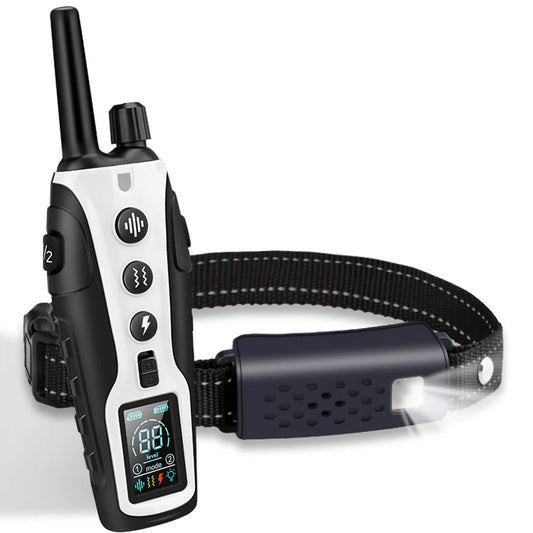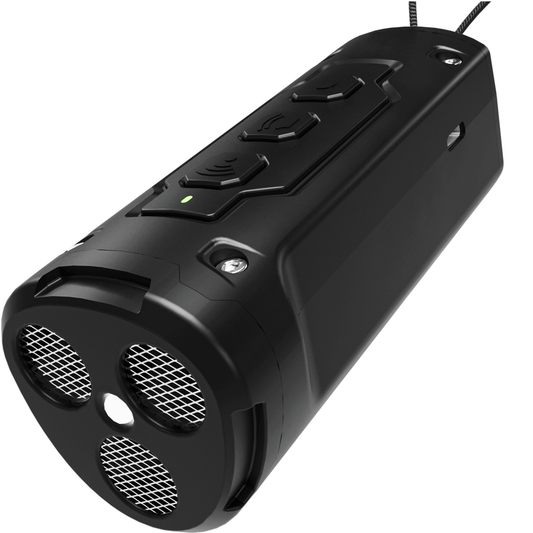Dog Won’t Stop Barking! A good anti-barking device can be an effective tool to help stop your dog from barking excessively. These devices are designed to emit a sound or other type of stimulus that will interrupt your dog's barking and redirect their attention. They can be helpful in situations where your dog's barking is disruptive or becoming a nuisance.
One way that anti-barking devices work is by emitting a high-pitched sound that is unpleasant to dogs but inaudible to humans. This sound interrupts your dog's barking and encourages them to stop. Some devices also emit a spray of citronella, which is unpleasant to dogs and can help stop barking behavior.
Anti-barking devices can also be useful for training your dog to bark less. For example, if your dog barks excessively at strangers, you can use a device that emits a sound or spray to interrupt their barking behavior. Over time, your dog will learn that barking in these situations is not acceptable and will begin to bark less frequently.
It is important to note that anti-barking devices should not be the only method used to address excessive barking behavior. They are most effective when used in conjunction with other training
positive reinforcement training and providing adequate exercise and mental stimulation. Additionally, it is important to consider the specific needs and personality of your dog when choosing an anti-barking device.
Dog Won’t Stop Barking
For example, some breeds are more sensitive to certain types of stimuli, so you may need to choose a device that is tailored to your dog's breed. Similarly, some dogs may have a more stubborn personality and require a more assertive device to interrupt their barking behavior.
When using an anti-barking device, it is important to use it responsibly and in a way that does not cause your dog harm or distress. It should never be used as a punishment for your dog's behavior, but rather as a tool to interrupt and redirect their barking.
It is also important to consult with a professional dog trainer or behaviorist before using an anti-barking device. They can provide guidance on the best approach to address your dog's excessive barking behavior and help you choose the right device for your dog's individual needs.
In conclusion, an anti-barking device can be a helpful tool to address excessive barking behavior in dogs. However, it should be used in conjunction with other training methods and with consideration for your dog's individual needs and personality. Seeking the advice of a professional dog trainer or behaviorist can also be beneficial in developing an effective plan to address your dog's barking behavior.
The importance of positive reinforcement training in addressing excessive barking behavior
Excessive barking is a common behavioral issue in dogs, and it can be frustrating for both pet owners and their neighbors. Fortunately, positive reinforcement training is a highly effective method for addressing this problem.
Positive reinforcement training involves rewarding good behavior and ignoring or redirecting unwanted behavior. In the case of excessive barking, this means praising and rewarding your dog when they are quiet and calm, and redirecting their attention or using a verbal cue when they start barking.
One of the key advantages of positive reinforcement training is that it helps build a stronger bond between you and your dog. By using positive reinforcement, you are communicating with your dog in a way that they understand and appreciate. This strengthens their trust in you and can make them more responsive to your training efforts.
Positive reinforcement training is also a humane and gentle approach to addressing excessive barking behavior. It avoids the use of punishment or aversive techniques, which can harm your dog's mental and emotional well-being.
When using positive reinforcement training to address excessive barking behavior, consistency and patience are key. It takes time for your dog to learn new behaviors, and it is important to remain calm and positive throughout the training process.
It is also important to address the underlying reasons behind your dog's excessive barking behavior. This may involve providing more exercise and mental stimulation, addressing separation anxiety, or identifying other triggers that are causing your dog to bark excessively. Dog Won’t Stop Barking
Excessive barking can be a nuisance for pet owners and their neighbors, but fortunately, there are a variety of anti-barking devices available to help address this issue. However, not all devices are created equal, and it is important to understand the different types and their potential effectiveness.
One type of anti-barking device is the ultrasonic device. This emits a high-pitched sound that is unpleasant to dogs but not audible to humans. The idea is that the sound will distract the dog and interrupt their barking. While ultrasonic devices can be effective in some cases, they may not work on all dogs, especially those who are hard of hearing.
Another type of anti-barking device is the citronella collar. These collars release a burst of citronella spray when the dog barks, which is unpleasant to dogs but not harmful. Some dogs find the scent of citronella to be soothing, so this method may not be effective for all dogs.
Dog Won’t Stop Barking
Shock collars are also a type of anti-barking device. These collars deliver a small electric shock to the dog when they bark. However, shock collars are controversial and have been associated with negative side effects, such as increased anxiety and aggression in some dogs. They should only be used as a last resort under the guidance of a professional dog trainer or behaviorist.
In addition to these devices, there are also vibration collars, which deliver a vibration to the dog's neck when they bark, and remote-controlled devices, which allow pet owners to manually trigger a sound or vibration when their dog barks.
When choosing an anti-barking device, it is important to consider your dog's personality and any underlying issues that may be causing their excessive barking. It is also important to use these devices appropriately and under the guidance of a professional, as misuse can harm your dog's well-being.
Dogs are active animals that require daily exercise and mental stimulation to maintain their physical and mental well-being. Without adequate exercise and mental stimulation, dogs may become bored, frustrated, and even develop excessive barking behavior.
Daily exercise is essential for dogs and can help reduce their energy levels and prevent boredom. Going for walks or runs, playing fetch, or engaging in other physical activities can tire your dog out and help reduce their barking behavior. Additionally, providing your dog with plenty of mental stimulation, such as puzzle toys, can help prevent boredom and reduce their need to bark excessively.
Training your dog to obey commands can also be an effective way to provide mental stimulation and reduce barking behavior. This can include teaching your dog to sit, stay, come, and other basic commands. Training sessions can be fun for both you and your dog and can help strengthen the bond between you.
Incorporating regular playtime into your dog's daily routine is another way to provide mental stimulation and reduce barking behavior. Playing with toys, such as tug-of-war or hide-and-seek, can be an enjoyable way to keep your dog entertained and prevent boredom.
Overall, providing your dog with adequate exercise and mental stimulation is essential in reducing their barking behavior. Consistency and patience are key when implementing these strategies, but with time and effort, you can help your furry friend lead a happier and healthier life with less excessive barking.
How to choose the right anti-barking device for your dog's specific needs and personality.
If your dog's excessive barking is becoming a problem, you may want to consider using an anti-barking device. However, with so many options available, it can be overwhelming to choose the right one for your dog's specific needs and personality. Here are some factors to consider when selecting an anti-barking device:
Type of Device: There are different types of anti-barking devices available, including collars, ultrasonic devices, and citronella sprays. Each type has its advantages and disadvantages, so it's important to consider which one would be most suitable for your dog.
Size and Breed: Some anti-barking devices may not be suitable for all dog sizes and breeds. For example, small dogs may not be able to wear certain collars comfortably, while larger dogs may require stronger ultrasonic devices.
Personality: Different dogs have different personalities, and some may be more sensitive to certain types of anti-barking devices. Consider your dog's temperament and what type of stimuli they respond to before selecting a device.
Effectiveness: It's important to choose an anti-barking device that is effective in reducing your dog's excessive barking. Look for devices with positive reviews and consider consulting with a veterinarian or dog trainer for recommendations.
Safety: Always prioritize your dog's safety when selecting an anti-barking device. Ensure that the device is safe to use and won't cause harm or discomfort to your dog.
Real-life success stories of using anti-barking devices can be inspiring and helpful for dog owners who are struggling with excessive barking from their own dogs or from their neighbor's dogs. Here are some real-life success stories of using anti-barking devices:
- Mary's dog was a constant barker, which was causing problems with her neighbors. She tried different training techniques, but nothing seemed to work. Finally, she decided to try an ultrasonic anti-barking device. The device emits a high-pitched sound that dogs can hear but humans can't. After a few days of consistent use, Mary noticed a significant reduction in her dog's barking. Her neighbors also reported that they were no longer hearing excessive barking from Mary's house.
- John's neighbor had two small dogs that barked non-stop, which was affecting John's quality of life. He tried talking to his neighbor, but the dogs continued to bark. Finally, John decided to try a bark control collar that emits a mild shock when the dog barks. He didn't want to harm the dogs, but he also needed a solution to the problem. After a few days of using the collar, John noticed a significant reduction in the dogs' barking. He was finally able to enjoy his own backyard without being disturbed by the constant barking.
- Samantha's dog had a tendency to bark excessively when left alone. This was causing problems with her apartment neighbors, who complained about the noise. Samantha tried leaving her dog with toys and treats to keep her occupied, but the barking persisted. Finally, she decided to try a spray collar that emits a burst of citronella when the dog barks. The scent is unpleasant to dogs and helps deter them from barking. After a few weeks of consistent use, Samantha noticed a significant reduction in her dog's barking. Her neighbors also reported that they were no longer hearing excessive barking from Samantha's apartment.
These real-life success stories show that anti-barking devices can be effective in controlling excessive barking. It's important to note that every dog is different and may respond differently to different types of devices. It's also important to use these devices responsibly and in a humane manner.
If you're considering using an anti-barking device, it's best to do research and consult with a professional to find the best solution for your specific situation.

Also, you can see our social media:




